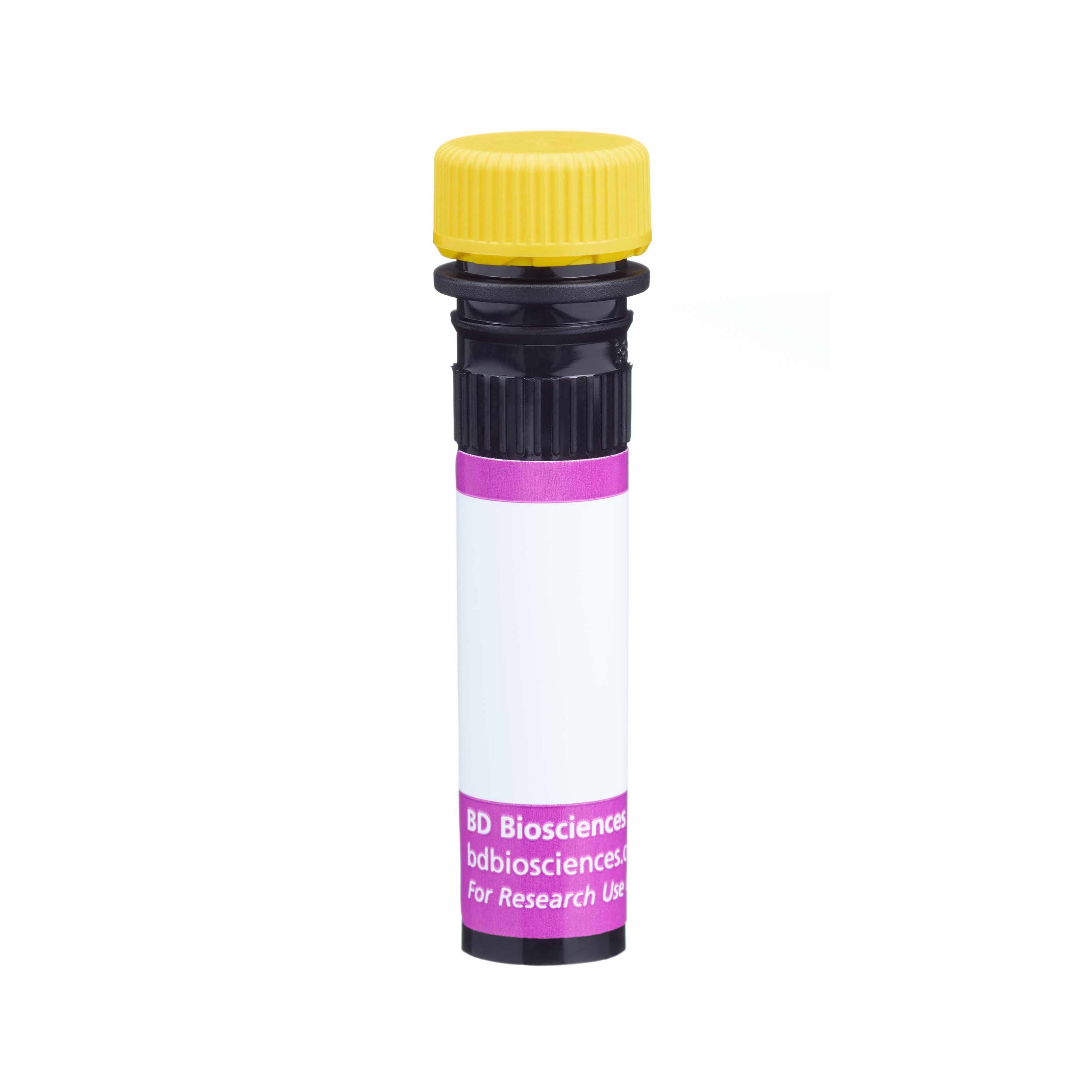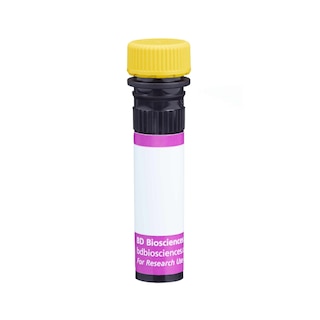-
Training
- Flow Cytometry Basic Training
-
Product-Based Training
- BD Accuri™ C6 Plus Cell Analyzer
- BD FACSAria™ Cell Sorter Cell Sorter
- BD FACSCanto™ Cell Analyzer
- BD FACSDiscover™ A8 Cell Analyzer
- BD FACSDiscover™ S8 Cell Sorter
- BD FACSDuet™ Sample Preparation System
- BD FACSLyric™ Cell Analyzer
- BD FACSMelody™ Cell Sorter
- BD FACSymphony™ Cell Analyzer
- BD LSRFortessa™ Cell Analyzer
- Advanced Training
Old Browser
This page has been recently translated and is available in French now.
Looks like you're visiting us from {countryName}.
Would you like to stay on the current location site or be switched to your location?
BD Horizon™ BV650 Mouse Anti-Human CD1c
Clone F10/21A3 (RUO)

Multiparameter flow cytometric analysis of CD1c expression on Human peripheral blood lymphocytes (Top Plots) and leucocyte populations (Bottom Plots). Human whole blood was stained with PE Mouse Anti-Human CD19 antibody (Cat. No. 555413/561741; Lower Plots) and with either BD Horizon™ BV650 Mouse IgG1, κ Isotype Control (Cat. No. 563231; Left Plots) or BD Horizon™ BV650 Mouse Anti-Human CD1c antibody (Cat. No. 569617; Right Plots) at 1.0 μg/test. The erythrocytes were lysed with BD FACS™ Lysing Solution (Cat. No. 349202).
Top Plots: The bivariate pseudocolor density plot showing the correlated expression of CD1c [or Ig Isotype control staining] versus CD19 was derived from gated events with the forward and side light-scatter characteristics of intact lymphocytes.
Bottom Plots: The bivariate pseudocolor density plot showing CD1c expression (or Ig Isotype control staining) versus side-light scatter (SSC-A) signals was derived from gated events with the forward and side light-scatter characteristics of intact leucocytes.
Flow cytometry and data analysis were performed using a BD LSRFortessa™ X-20 Cell Analyzer System and FlowJo™ software. Data shown on this Technical Data Sheet are not lot specific.



Multiparameter flow cytometric analysis of CD1c expression on Human peripheral blood lymphocytes (Top Plots) and leucocyte populations (Bottom Plots). Human whole blood was stained with PE Mouse Anti-Human CD19 antibody (Cat. No. 555413/561741; Lower Plots) and with either BD Horizon™ BV650 Mouse IgG1, κ Isotype Control (Cat. No. 563231; Left Plots) or BD Horizon™ BV650 Mouse Anti-Human CD1c antibody (Cat. No. 569617; Right Plots) at 1.0 μg/test. The erythrocytes were lysed with BD FACS™ Lysing Solution (Cat. No. 349202).
Top Plots: The bivariate pseudocolor density plot showing the correlated expression of CD1c [or Ig Isotype control staining] versus CD19 was derived from gated events with the forward and side light-scatter characteristics of intact lymphocytes.
Bottom Plots: The bivariate pseudocolor density plot showing CD1c expression (or Ig Isotype control staining) versus side-light scatter (SSC-A) signals was derived from gated events with the forward and side light-scatter characteristics of intact leucocytes.
Flow cytometry and data analysis were performed using a BD LSRFortessa™ X-20 Cell Analyzer System and FlowJo™ software. Data shown on this Technical Data Sheet are not lot specific.


Multiparameter flow cytometric analysis of CD1c expression on Human peripheral blood lymphocytes (Top Plots) and leucocyte populations (Bottom Plots). Human whole blood was stained with PE Mouse Anti-Human CD19 antibody (Cat. No. 555413/561741; Lower Plots) and with either BD Horizon™ BV650 Mouse IgG1, κ Isotype Control (Cat. No. 563231; Left Plots) or BD Horizon™ BV650 Mouse Anti-Human CD1c antibody (Cat. No. 569617; Right Plots) at 1.0 μg/test. The erythrocytes were lysed with BD FACS™ Lysing Solution (Cat. No. 349202).
Top Plots: The bivariate pseudocolor density plot showing the correlated expression of CD1c [or Ig Isotype control staining] versus CD19 was derived from gated events with the forward and side light-scatter characteristics of intact lymphocytes.
Bottom Plots: The bivariate pseudocolor density plot showing CD1c expression (or Ig Isotype control staining) versus side-light scatter (SSC-A) signals was derived from gated events with the forward and side light-scatter characteristics of intact leucocytes.
Flow cytometry and data analysis were performed using a BD LSRFortessa™ X-20 Cell Analyzer System and FlowJo™ software. Data shown on this Technical Data Sheet are not lot specific.




Regulatory Status Legend
Any use of products other than the permitted use without the express written authorization of Becton, Dickinson and Company is strictly prohibited.
Preparation And Storage
Recommended Assay Procedures
BD® CompBeads can be used as surrogates to assess fluorescence spillover (compensation). When fluorochrome conjugated antibodies are bound to BD® CompBeads, they have spectral properties very similar to cells. However, for some fluorochromes there can be small differences in spectral emissions compared to cells, resulting in spillover values that differ when compared to biological controls. It is strongly recommended that when using a reagent for the first time, users compare the spillover on cells and BD® CompBeads to ensure that BD® CompBeads are appropriate for your specific cellular application.
For optimal and reproducible results, BD Horizon Brilliant™ Stain Buffer should be used anytime BD Horizon Brilliant dyes are used in a multicolor flow cytometry panel. Fluorescent dye interactions may cause staining artifacts which may affect data interpretation. The BD Horizon Brilliant Stain Buffer was designed to minimize these interactions. When BD Horizon Brilliant Stain Buffer is used in in the multicolor panel, it should also be used in the corresponding compensation controls for all dyes to achieve the most accurate compensation. For the most accurate compensation, compensation controls created with either cells or beads should be exposed to BD Horizon Brilliant Stain Buffer for the same length of time as the corresponding multicolor panel. More information can be found in the Technical Data Sheet of the BD Horizon Brilliant Stain Buffer (Cat. No. 563794/566349) or the BD Horizon Brilliant Stain Buffer Plus (Cat. No. 566385).
Product Notices
- Please refer to www.bdbiosciences.com/us/s/resources for technical protocols.
- Since applications vary, each investigator should titrate the reagent to obtain optimal results.
- An isotype control should be used at the same concentration as the antibody of interest.
- Caution: Sodium azide yields highly toxic hydrazoic acid under acidic conditions. Dilute azide compounds in running water before discarding to avoid accumulation of potentially explosive deposits in plumbing.
- For fluorochrome spectra and suitable instrument settings, please refer to our Multicolor Flow Cytometry web page at www.bdbiosciences.com/colors.
- BD Horizon Brilliant Violet 650 is covered by one or more of the following US patents: 8,110,673; 8,158,444; 8,227,187; 8,455,613; 8,575,303; 8,354,239.
- BD Horizon Brilliant Stain Buffer is covered by one or more of the following US patents: 8,110,673; 8,158,444; 8,575,303; 8,354,239.
- Human donor specific background has been observed in relation to the presence of anti-polyethylene glycol (PEG) antibodies, developed as a result of certain vaccines containing PEG, including some COVID-19 vaccines. We recommend use of BD Horizon Brilliant™ Stain Buffer in your experiments to help mitigate potential background. For more information visit https://www.bdbiosciences.com/en-us/support/product-notices.
- Please refer to http://regdocs.bd.com to access safety data sheets (SDS).
- Alexa Fluor™ is a trademark of Life Technologies Corporation.
- For U.S. patents that may apply, see bd.com/patents.
Companion Products






The F10/21A3 monoclonal antibody specifically binds to CD1c. The CD1 family of transmembrane glycoproteins are structurally related to the classical major histocompatibility complex (MHC) proteins. CD1c is a type I transmembrane glycoprotein that forms heterodimers with beta-2-microglobulin. CD1c presents lipids and glycolipids of self or microbial origin to T cells. CD1c is expressed by Langerhans cells, dendritic cells, monocytes, cortical thymocytes, T cells, and some B cells.

Development References (4)
-
Delia D, Cattoretti G, Polli N, et al. CD1c but neither CD1a nor CD1b molecules are expressed on normal, activated, and malignant human B cells: identification of a new B-cell subset. Blood. 1988; 72(1):241-247. (Biology). View Reference
-
Grant EP, Degano M, Rosat JP, et al. Molecular recognition of lipid antigens by T cell receptors. J Exp Med. 1999; 189(1):195-205. (Clone-specific: Blocking, Functional assay, Inhibition). View Reference
-
Melian A, Geng YJ, Sukhova GK, Libby P, Porcelli SA. CD1 expression in human atherosclerosis. A potential mechanism for T cell activation by foam cells. Am J Pathol. 1999; 155(3):775-786. (Immunogen: Flow cytometry). View Reference
-
Moody DB, Ulrichs T, Mühlecker W, et al. CD1c-mediated T-cell recognition of isoprenoid glycolipids in Mycobacterium tuberculosis infection. Nature. 2000; 404(6780):884-888. (Clone-specific: Blocking, Functional assay, Inhibition). View Reference
Please refer to Support Documents for Quality Certificates
Global - Refer to manufacturer's instructions for use and related User Manuals and Technical data sheets before using this products as described
Comparisons, where applicable, are made against older BD Technology, manual methods or are general performance claims. Comparisons are not made against non-BD technologies, unless otherwise noted.
For Research Use Only. Not for use in diagnostic or therapeutic procedures.